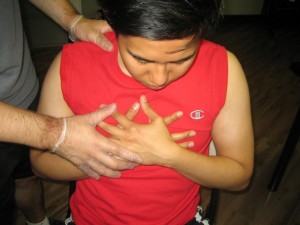Pulmonary hypertension is a form of high blood pressure that involves the arteries in the lungs and right side of the heart. In one variant of pulmonary hypertension, the small-sized arteries in the lungs becomes blocked or damaged, thus making it hard for blood to flow to the lungs and places pressure on the arteries. With the buildup of pressure, the lower right chamber of the heart or the right ventricle works hard in pumping blood through the lungs and results to weakening of the heart muscles that eventually fail to function properly.
Symptoms of pulmonary hypertension
- Shortness of breath or dyspnea especially while performing exercises and resting
- Dizziness or fainting spells
- Fatigue or tiredness
- Chest pain or pressure
Shortness of breath or dyspnea especially while performing exercises and resting - Racing pulse or heart palpitations
- Bluish color of the lips and skin due to lack of oxygen in the blood
- Swelling or edema in the legs, ankles and eventually in the abdomen or ascites
- Lack of appetite
- Fast heartbeat
Treatment
- Take plenty of rest to lessen fatigue caused by pulmonary hypertension.
- Maintain regular activities such as walking with oxygen. Avoid lifting heavy weights to prevent worsening of the condition.
- Avoid smoking and exposure to second hand smoke.
- Avoid traveling or living at high altitudes such as 8,000 feet or higher to prevent worsening of the condition.
- Avoid situations that can worsen the condition such taking hot baths or shower for a longer time and sitting in hot tubs or sauna to prevent lowering of the blood pressure that can result to fainting and eventually death.
- Consume a nutritious diet and maintain a normal weight. Eat whole grains, variety of fresh fruits and vegetables, low-fat dairy products and lean meats. Avoid saturated fats, Trans fat and cholesterol.
- Garlic is rich in antioxidants and polyphenol. Chop finely a few cloves of garlic and wait for at least 5 minutes before mixing it with food.
- Perform regular exercises to keep the body active as much as possible.
- Eat foods rich in vitamin C and E such a grapes, onions, apples, red wine, prunes and soy protein.
- Perform some relaxation and breathing techniques such as yoga to help stabilize pulmonary conditions. Perform meditations for at least 5-10 minutes every day to lessen stress and anxiety, relax the brain and prevent any heart and lung diseases.
Disclaimer
The material posted on this page for pulmonary hypertension is for learning purposes only. If you want to learn to more about circulatory conditions including pulmonary hypertension, register for a first aid course with a training provider near you.

